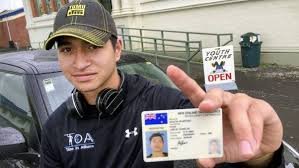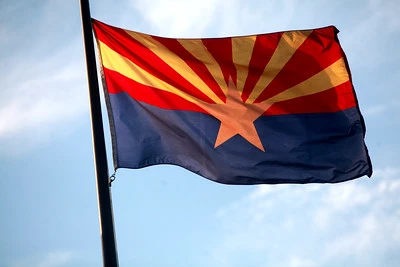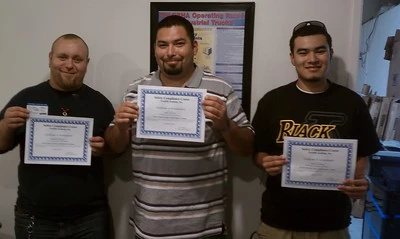What is the Meaning of a Forklift License?
April 10, 2024 | by onlineoshasafetytraining.com


A forklift license, also known as an operator card, serves as proof that the person holding it has completed the necessary training and certification to operate a forklift. This document is essential in ensuring that all forklift operators have the skills and knowledge to use these machines safely and efficiently, adhering to workplace safety standards and regulations.
The certification process typically includes both practical and theoretical components, covering safe operation techniques, understanding of load capacities, maneuvering, and maintenance, as well as other essential skills needed to operate a forklift in various environments.
A forklift license, or operator card, typically includes several key pieces of information to verify the holder’s qualifications and certifications to operate a forklift. Here are some of the common details found on a forklift license:
- Operator’s Name: The full name of the person certified to operate the forklift.
- Photograph: A recent photo of the operator for identification purposes.
- License Number: A unique identifier for the license.
- Issuing Organization: The name of the organization that provided the training and issued the license.
- Type of Forklift Certification: Specifies the types of forklifts the operator is certified to use, such as counterbalance, reach truck, or pallet jack.
- Date of Issue: The date when the license was issued.
- Expiration Date: The date when the license is due for renewal. Forklift certifications typically need to be renewed every 2-3 years, though this can vary by jurisdiction.
- Operator’s Signature: A signature from the operator, confirming the accuracy of the information on the card.
- Training or Certification Details: This might include specific skills the operator has been trained in, such as safety procedures, forklift maintenance, and handling of hazardous materials.
- Restrictions or Limitations: If applicable, any limitations on the operator’s certification, such as restrictions to certain types of loads or environments, will be noted.
This information helps employers and safety officers ensure that forklift operators on their sites have the proper training and certification to operate the equipment safely and effectively.
Does It Have to Come With a Certificate?
Whether you receive a certificate along with your forklift license can vary depending on where and how you get your training.
In many situations, the organization that provides the forklift training will give you both a license and a certificate. This certificate is a formal document that states you have completed the necessary training and assessments to operate a forklift safely.
However, there are cases, especially when the training and certification are done by the company you work for (known as in-house training), where you might not receive a separate certificate. Instead, your employer may directly issue a forklift license or operator card as proof of your training and certification.
In either scenario, the important part is that you have documentation proving you have completed the required training in line with OSHA’s standard 29 CFR 1910.178. This could be a formal certificate, a license, or another form of documentation provided by your employer. What matters most is that this documentation serves as evidence of your capability to operate a forklift safely and in compliance with OSHA regulations.
Issuing a Forklift License Complies with the OSHA Standard; 1910.178(l)(6)
When a company gives out a forklift license, it makes sure it follows a specific rule set by OSHA, which is Standard 1910.178(l)(6). This rule is all about making sure forklift drivers are properly trained and checked to see if they can safely operate a forklift.
Here’s what it means: The company has to keep a record for each person who drives a forklift. This record needs to have the forklift driver’s name, when they were trained when they were checked to see how well they can use the forklift, and who did the training and checking. This isn’t just paperwork; it’s a way to prove that the driver has learned and shown they can handle a forklift without causing danger to themselves or others.
By doing this, the company is not only following the law but also making sure that everyone working with or around forklifts is as safe as possible. It’s a critical step in reducing accidents and injuries in places where forklifts are used.
A forklift License is Strong Evidence You Can Show to OSHA Inspector

When OSHA inspectors come to your place of work, showing them your forklift license is very important. This license proves you know how to use a forklift the right way and safely. It helps keep you and your boss from getting in trouble, like getting fines or warnings from OSHA.
OSHA, which stands for Occupational Safety and Health Administration, has a rule called OSHA standard 29 CFR 1910.178. This rule says that anyone who drives a forklift must be properly trained and certified. Your forklift license is proof that you meet this rule because it shows you finished your training and passed all the tests.
Having this license means:
- You learned how to drive a forklift safely.
- You understand how to avoid accidents at work.
- You and your employer follow OSHA’s safety rules.
So, having a forklift license is not just about being allowed to drive a forklift. It’s also about making sure your workplace is safe and follows the law, which keeps everyone from getting fines or other penalties from OSHA.
How to Get a Forklift License
To get a forklift license, you need to follow some steps. These steps make sure you know how to safely use a forklift. Here’s a simple guide on how to do it, including some industry terms and important details:
Basic Requirements for Getting a Forklift License:
- Age: You must be at least 18 years old.
- Physical Condition: Good health is required, as forklift operation can be physically demanding.
- Safety Knowledge: Understanding basic safety rules is essential.
Overview of the Process to Obtain a Forklift License:
Training Courses:
- Enroll in a Training Program: Find a certified training program. These programs are often offered by employers, trade schools, or safety organizations. You can take the training program either in-person or through an online course.
- Learn Forklift Types: Get to know different forklifts, like counterbalance forklifts (common for lifting pallets) and reach trucks (used in warehouses).
- Understand Technical Terms: Learn terms like “load capacity” (maximum weight a forklift can carry), “mast” (the part that lifts the load), and “stability triangle” (a concept for preventing tip-overs).
Exams and Evaluations:
- Written Test: After completing the training course, you’ll take a written test that covers safety procedures, forklift operation, and maintenance. This follows after completing the classroom training part of the course.
- Practical Test: You must also pass a practical test where you demonstrate your ability to operate a forklift safely. This might include tasks like lifting and moving loads, navigating through obstacle courses, and proper parking techniques. The examiner will do the practical test which usually takes about less than 2 hours to complete depending on the type of truck.
- Evaluation: Some programs require a workplace evaluation, where an instructor observes you operating a forklift during actual work tasks.
After successfully completing these steps, you will receive your forklift license or operator card. This license may need to be renewed every 2-3 years, depending on local regulations. Remember, having this license shows employers that you have the necessary skills and knowledge to operate a forklift safely and efficiently.
Maintaining Your Forklift License
Keeping your forklift license up to date is important for your job. Here’s how to do it:
Renewal Process for a Forklift License:
- Check Expiration Date: Your forklift license will have an expiration date, often every 2-3 years. Mark this date so you don’t forget it.
- Apply for Renewal: Before your license expires, you’ll need to apply for renewal. This might mean contacting the organization that issued your license or your employer.
- Update Training: Some places require you to take a short training course again to make sure you know the latest safety rules and forklift operating procedures.
- Retake Tests: You may need to pass the written and practical tests again to show you can still operate a forklift safely.
Continuing Education and Training:
- Safety Updates: Safety methods and rules can change. Stay informed about new safety guidelines in the forklift industry.
- Advanced Courses: Consider taking advanced forklift training courses. These might include learning how to operate different types of forklifts, like those that can lift loads higher than 6 feet or handle hazardous materials.
- Skills Improvement: Practice your forklift operating skills regularly. This can help you become more efficient and reduce the risk of accidents.
- Workplace Safety Meetings: Attend safety meetings at work. These meetings can give you important information about keeping safe while operating a forklift.
By following these steps, you can keep your forklift license valid. This helps make sure that you can keep working as a forklift operator and stay safe on the job. Remember, being a skilled forklift operator is not just about having a license; it’s also about being responsible and keeping up with your training and education.
You Need To Renew Your License
The requirement to renew your forklift license every three years can vary depending on which country you’re in, because different countries have their own standards and laws for forklift training. This rule is in place to make sure that forklift operators keep their skills and knowledge up to date, ensuring they can operate forklifts safely and effectively.
Regular renewal often involves going through some form of re-evaluation or continuing education related to forklift operation. This could include a refresher course on safety practices, updates on new forklift technologies, or changes in workplace safety regulations. The goal is to maintain a high level of safety and efficiency in environments where forklifts are used, reducing the risk of accidents and injuries.
United States
- Renewal Period: Every 3 years. OSHA requires forklift operators to be evaluated every three years to determine if they need additional training.
Canada
- Renewal Period: Similar to the US, it’s generally every 3 years. However, this can vary by province, so it’s important to check local regulations.
Australia
- Renewal Period: In Australia, the requirement can vary. For a high-risk work license (which includes forklift operation), the renewal is typically every 5 years. Again, specific conditions can apply depending on the state or territory.
United Kingdom
- Renewal Period: There’s no fixed statutory period for forklift license renewal set by the Health and Safety Executive (HSE); however, it is recommended that operators undergo a refresher course every 3 to 5 years, depending on the operator’s experience, workplace environment, and risk assessment.
So, if you’re a forklift operator, it’s important to stay informed about the specific requirements for license renewal in your country, including any necessary training or evaluation processes. This ensures not only your compliance with local laws but also your continued competence and safety in operating forklifts.
What Does Forklift Certified Mean?
Being “forklift certified” means you’ve taken special training and passed tests that prove you can safely operate a forklift. A forklift is a type of vehicle used in many workplaces, like warehouses and construction sites, to lift and move heavy stuff. They can lift loads as light as a few hundred pounds to as heavy as over 35,000 pounds – that’s as heavy as about 10 cars stacked together!
In the training to become certified, you learn important things like how to balance heavy loads so they don’t tip over, move through tight spaces without hitting anything, and keep yourself and others safe. You’ll hear terms like “load capacity” (how much weight the forklift can carry), “stability triangle” (a rule to help keep the forklift from tipping over), and “operating speed” (how fast you can safely drive the forklift).
After you finish your training, you take a written test and a driving test to show you know your stuff. When you pass, you get certified. This means you have special permission that says you’re trained to handle a forklift right. This is super important because using a forklift the wrong way can be really dangerous. Plus, being certified is a must according to safety rules from organizations like OSHA to make sure everyone at work stays safe.
To Make a Conclusion
A forklift license is like a special pass that shows you know how to safely drive and handle a forklift. It’s important because forklifts can be dangerous if not used correctly, and this license proves you’ve been trained to use them the right way. Whether you get this license and maybe a certificate from a training place or your own workplace, it means you’re all set to operate a forklift.
This isn’t just good for keeping you and everyone else safe at work, but it also follows the rules set by OSHA, making sure you and your employer stay out of trouble. So, in short, a forklift license is your ticket to safely and legally driving a forklift on the job.
RELATED POSTS
View all


